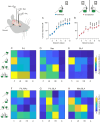Involvement of prelimbic cortex neurons and related circuits in the acquisition of a cooperative learning by pairs of rats
- PMID: 39555258
- PMCID: PMC11564578
- DOI: 10.1007/s11571-024-10107-y
Involvement of prelimbic cortex neurons and related circuits in the acquisition of a cooperative learning by pairs of rats
Abstract
Social behaviors such as cooperation are crucial for mammals. A deeper knowledge of the neuronal mechanisms underlying cooperation can be beneficial for people suffering from pathologies with impaired social behavior. Our aim was to study the brain activity when two animals synchronize their behavior to obtain a mutual reinforcement. In a previous work, we showed that the activity of the prelimbic cortex (PrL) was enhanced during cooperation in rats, especially in the ones leading most cooperative trials (leader rats). In this study, we investigated the specific cells in the PrL contributing to cooperative behaviors. To this end, we collected rats' brains at key moments of the learning process to analyze the levels of c-FOS expression in the main cellular groups of the PrL. Leader rats showed increased c-FOS activity in cells expressing D1 receptors during cooperation. Besides, we analyzed the levels of anxiety, dominance, and locomotor behavior, finding that leader rats are in general less anxious and less dominant than followers. We also recorded local field potentials (LFPs) from the PrL, the nucleus accumbens septi (NAc), and the basolateral amygdala (BLA). A spectral analysis showed that delta activity in PrL and NAc increased when rats cooperated, while BLA activity in delta and theta bands decreased considerably during cooperation. The PrL and NAc also increased their connectivity in the high theta band during cooperation. Thus, the present work identifies the specific PrL cell types engaged in this behavior, as well as the way this information is propagated to selected downstream brain regions (BLA, NAc).
Supplementary information: The online version contains supplementary material available at 10.1007/s11571-024-10107-y.
Keywords: Basolateral amygdala; C-Fos; Cooperative behavior; D1; D2 receptors; Local field potential; Nucleus accumbens septi; Operant conditioning; Prelimbic cortex.
© The Author(s) 2024.
Conflict of interest statement
Competing interestAuthors declare no competing interests in relation to this work.
Figures









References
-
- Bertocchi I, Rocha-Almeida F, Romero-Barragán MT, Cambiaghi M, Carretero-Guillén A, Botta P, Dogbevia GK, Treviño M, Mele P, Oberto A, Larkum ME, Gruart A, Sprengel R, Delgado-García JM, Hasan MT (2023) Pre- and postsynaptic N-methyl-d-aspartate receptors are required for sequential printing of fear memory engrams. Iscience 26(11):108050. 10.1016/j.isci.2023.108050 - PMC - PubMed
LinkOut - more resources
Full Text Sources

